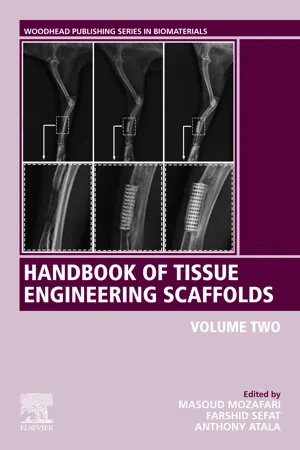34.1. Overview of brain reconstruction: scaffold types and design objectives
The brain is the most complex organ in the human body, functionally comprised of over 100 billion nerve cells, called neurons, that are precisely interconnected by a sophisticated network of over 100,000 miles of fibrous extensions, called axons [1,2]. These exquisite neuronal–axonal networks are complimented by an array of specialized support cells, collectively called glia, that are 10 times more numerous than neurons yet fulfill necessary roles including providing structural, trophic, metabolic, and functional support for neurons and axonal tracts [1]. The focus of this chapter is on brain repair, specifically emerging strategies to facilitate regeneration, reconnectivity, and/or reconstruction of these exquisite neuronal–axonal–glial networks following degeneration caused by brain injury or neurodegenerative disease. Focus is given to engineered scaffold-based approaches; in particular, efforts encompassing naturally occurring organic/biologically derived scaffolds (e.g., extracellular matrices (ECMs)), non-ECM polymer-based scaffolds (e.g., hydrogels), and so-called “living scaffolds” (e.g., anisotropic cell-laden scaffolds). In general, these biomaterial/biological scaffolds aim to fill defects, provide structural support, provide guidance cues (generally anisotropic), deliver biological agents, and/or provide preorganized cells. The design criteria for these scaffolds are generally determined by the desired mechanism(s) of action, which for brain repair generally fall into three categories: (1) neuroprotection by providing prosurvival cues (growth factors) and/or supporting cells; (2) cell replacement by eliciting neurogenesis, glial proliferation, orchestrating (endogenous) cell migration, and/or providing new (exogenous) cells, with varying degrees of three-dimensional (3D) architecture; and (3) neurite pathfinding (generally axonal) to restore local connections and/or reconstruct long-distance circuitry. The ultimate goal of these therapies is to prevent cell/axonal loss, promote healing, reconstruct lost neural architecture/connections, and ultimately facilitate functional recovery following nervous system disorders.
34.2. Nervous system function, anatomy, and cellular architecture
Effective strategies to facilitate brain reconstruction require an appreciation of the sophisticated architecture (spanning micro- to macroscales), multicellular composition, and unique functional domains found across the nervous system [1,3]. In total, the nervous system serves as the body’s communication and control network. A complex collection of specialized cells gathers and processes information from various sources, routes the information to the appropriate locations, and generates responses to the information to elicit a range of physiological functions [1,4,5]. The information may relate to the external environment, the body’s position and orientation in space, or various tissue, organ, and system-level phenomena [1,5]. Functionally, the nervous system is subdivided into the somatic (associated with conscious control such as movement) and the autonomic (responsible for unconscious/involuntary behavior such as breathing or digestion) nervous systems [1,6]. Anatomically, the nervous system has two primary components—the central nervous system (CNS), comprises the brain and spinal cord, and the peripheral nervous system, encompassing the nerves that bridge the CNS to the rest of the body [1].
The focus of this chapter is on the brain, which serves as the primary mammalian processing and coordination center. Information about the environment (i.e., external stimuli) and the body’s structural and functional behavior (e.g., proprioception) is encoded as electrical signals that are transmitted along axons—long fibers or tracts projecting from neurons—for feature extraction, processing, and integration and redirection to appropriate subnetworks within the brain [1]. S...
